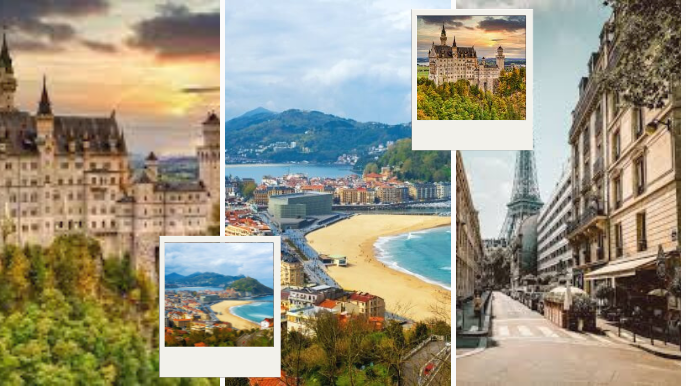How To
How to Plan the Perfect Multi-Country European Adventure
Published
5 months agoon
By
Admin
Europe is a dream destination for many travelers, offering a rich tapestry of history, culture, and stunning landscapes. With so many countries to explore, planning a multi-country European adventure can be both exciting and overwhelming. The good news is that with a little planning and some insider tips, you can easily craft the perfect European itinerary that allows you to explore multiple countries and experience the best each destination has to offer. Here’s how to plan the ultimate European adventure, from choosing your destinations to the best modes of transportation.
1. Define Your Travel Goals
Before diving into the specifics of your multi-country European trip, it’s important to define your goals for the journey. Are you interested in art, history, and architecture? Or do you want to focus more on nature, food, and local culture? Your preferences will shape your itinerary and the countries you choose to visit.
- Culture and History: If you’re fascinated by history and art, cities like Paris, Rome, Florence, and Berlin will be top contenders. Iconic landmarks such as the Colosseum, the Louvre Museum, and the Berlin Wall will provide endless exploration opportunities.
- Nature and Outdoor Adventures: If hiking, nature, and outdoor exploration appeal to you, consider destinations like Switzerland, Norway, and Austria. The Swiss Alps, the fjords of Norway, and the hiking trails around Austria’s lakes offer unparalleled natural beauty.
- Food and Wine: For food lovers, countries like Italy, France, Spain, and Greece will offer rich culinary experiences. From fresh pasta in Rome to tapas in Madrid or Greek souvlaki in Athens, every meal is an adventure in itself.
Once you’ve decided what you want to focus on, you can start narrowing down your travel destinations.
2. Select Your Destinations and Create an Itinerary
The next step is to choose the countries you want to visit. Depending on the amount of time you have, it’s important to be realistic about the number of countries you can explore. Trying to visit too many destinations in a short period of time can feel rushed and prevent you from fully immersing yourself in each place.
A good strategy is to focus on regions that are close together, which will help minimize travel time between countries. For example, visiting countries in Western Europe such as France, Belgium, the Netherlands, and Germany makes sense geographically and allows for easy train travel between cities.
- Western Europe: Cities like Paris, Amsterdam, Brussels, and Berlin offer a combination of culture, history, and nightlife. You can easily hop from one city to the next by high-speed train, giving you plenty of time to explore without feeling like you’re in a constant rush.
- Southern Europe: For a combination of sun, sea, and rich history, consider a journey through Spain, Italy, and Greece. Enjoy the Mediterranean weather, explore ancient ruins, and sample delicious Mediterranean cuisine.
- Eastern Europe: If you’re seeking adventure off the beaten path, consider countries like Poland, Hungary, Czech Republic, and Austria. These destinations are less tourist-heavy than their Western European counterparts but are equally rich in history, charm, and culture.
3. Budget and Time Management
One of the most important aspects of planning any multi-country trip is budgeting. Europe can be an expensive continent to travel through, but with careful planning, you can keep costs under control. Here are a few tips to help you stick to your budget:
- Accommodation: Booking accommodation well in advance can help you find the best deals. Consider staying in mid-range hotels, boutique hostels, or even Airbnb for more local experiences. In major cities like Paris or Rome, booking a place near the city center can sometimes be pricier, so you may want to consider staying a little outside the main tourist areas and using public transportation to get around.
- Transportation: When traveling across multiple countries, transportation costs can add up quickly. One option is to look into rail passes, such as the Eurail Pass, which allows you to travel by train between multiple countries at a fixed price. Alternatively, consider budget airlines for longer distances or, if you’re exploring coastal regions, look into options like a British Isles cruise that might connect various destinations while offering scenic views.
- Dining: While dining out in Europe can be pricey, you can save money by eating like a local. Seek out markets, local eateries, and food stalls for fresh, affordable meals. Street food in cities like Berlin or Barcelona is often both delicious and inexpensive.
4. Choose Your Mode of Travel
When it comes to traveling between countries, Europe offers several convenient and efficient options. Your choice of transportation will depend on the distance between countries, the amount of time you have, and your budget.
- Train Travel: Europe’s rail network is extensive, making trains one of the best ways to travel between countries. High-speed trains like the TGV (France), ICE (Germany), and Eurostar (UK to France) can get you between major cities quickly and comfortably. For a more scenic and leisurely journey, you can also explore regional trains through picturesque areas like the Swiss Alps or the Italian countryside.
- Flights: Budget airlines like Ryanair, EasyJet, and Wizz Air offer low-cost flights between major European cities. Flights are a great option if you’re traveling long distances, such as from Spain to Greece or from France to Croatia. Just keep an eye on baggage fees and other hidden charges when booking.
- Cruises: If you’re traveling around coastal regions or islands, cruises can be an exciting way to explore multiple countries in a relaxed setting. A British Isles cruise, for example, can take you through cities in the UK and Ireland, offering both leisurely exploration and the chance to discover several countries in one trip. Cruising is especially appealing if you enjoy comfort and scenic views as you travel.
- Car Rentals: Renting a car gives you the freedom to explore more remote areas or travel at your own pace. If you’re visiting countries with well-maintained roads, such as Spain, Italy, or France, a road trip can be an unforgettable way to experience the countryside, visit small towns, and stop at charming villages along the way.
5. Explore and Immerse Yourself in Local Culture
One of the best parts of traveling through multiple European countries is immersing yourself in the diverse cultures. Each country has its own unique identity, which is reflected in everything from food and architecture to festivals and traditions.
- Cuisine: Don’t miss out on trying local dishes in each country you visit. Indulge in tapas in Spain, fresh pasta in Italy, pastries in France, and sausages in Germany. Food is an essential part of the European experience, and each country has its culinary specialties.
- Language and Etiquette: While English is widely spoken in many European countries, learning a few basic phrases in the local language can go a long way in making connections and showing respect for the culture. In addition, familiarize yourself with local customs and etiquette, such as tipping practices, greetings, and table manners, to ensure a smooth experience.
- Local Attractions: Aside from the major tourist attractions, be sure to seek out hidden gems, such as local markets, less-known museums, and off-the-beaten-path neighborhoods. Walking tours or local guides can help you get a deeper understanding of the history and significance of the places you visit.
6. Pack Smart and Prepare for Changeable Weather
Europe is known for its diverse climate, so packing smart is essential. Make sure to check the weather for each country you’ll be visiting and bring layers to adjust to changing temperatures. Comfortable shoes are also a must, as you’ll likely be doing a lot of walking while exploring cities and attractions.
Conclusion
Planning a multi-country European adventure is an exciting challenge that allows you to experience the richness of the continent in a way that’s personalized to your interests. By carefully selecting destinations, managing your budget, and choosing the right modes of travel, you can create an itinerary that offers a balance of exploration, relaxation, and cultural immersion. Whether you decide to explore by train, take a British Isles cruise for a scenic adventure, or rent a car for a road trip through the countryside, Europe has an endless array of opportunities to make your travel dreams come true.
Read Also : Yellowstone Season 6: What to Expect from the Hit Series

The KUKOO Creative Approach to Branding: From Vision to Visuals.

Marie Solimena Joins GIO Gelati to Bring a Taste of Italy to a Wider World

A Comprehensive Guide to Choosing the Right Customer Service Software

5 Habits That Will Help You Build Mental Strength

Sildenafil Tablets: The Go-To Treatment for Erectile Dysfunction

The Art of Fragrance Design: How Jarsking’s Team Elevates Perfume Packaging in 2025

The Popularity of Tungsten Wedding Rings for Men

Capsule Wardrobe for Toddler Boys

Why Workplace Aesthetics Are a Strategic Investment, Not a Luxury

Celebrate Tradition: Europe’s Most Enchanting Fairs and Festivals

How to Create a Successful Crowdfunding Campaign Video

Binary Options Broker Selection Made Easy

Elevate Your Summer Wardrobe with These Stylish Cardigan Looks

Castle App Free Download — Updated 2024 Version

10 Best Fake ID Websites 2025

Private Proxies for Secure and Anonymous Online Activities

How to Write a Check: A Step-by-Step Guide to Mastering This Essential Skill

Harry Bring: A Name Synonymous with Excellence and Innovation

Treatment in the best hospitals abroad

Phone Fashion: Trends and Styles in Custom Case Design

The KUKOO Creative Approach to Branding: From Vision to Visuals.

Marie Solimena Joins GIO Gelati to Bring a Taste of Italy to a Wider World

A Comprehensive Guide to Choosing the Right Customer Service Software

5 Habits That Will Help You Build Mental Strength

Sildenafil Tablets: The Go-To Treatment for Erectile Dysfunction

The Art of Fragrance Design: How Jarsking’s Team Elevates Perfume Packaging in 2025

The Popularity of Tungsten Wedding Rings for Men

Capsule Wardrobe for Toddler Boys

Why Workplace Aesthetics Are a Strategic Investment, Not a Luxury





